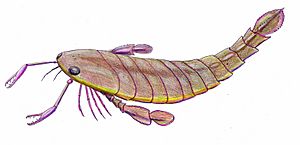Pterygotus facts for kids
Pterygotus anglicus was an amazing ancient creature! It was a type of Eurypterid, which are often called "sea scorpions." But don't worry, they weren't true scorpions, though they were related to arachnids (like spiders and modern scorpions). This incredible animal lived a very long time ago, during the Silurian and Devonian periods. That's roughly 443 to 359 million years ago!
Fossils of Pterygotus have been discovered all over the world. Scientists have found them in places like North America, South America, Europe, and Australia. This shows that these "sea scorpions" were very widespread. Pterygotus was related to an even bigger eurypterid called Jaekelopterus. It also looked a bit like a freshwater eurypterid named Slimonia.
Pterygotus was quite large for an invertebrate. It could grow up to 1.6 meters (about 5.2 feet) long! Imagine seeing something that big swimming in ancient seas. It had two big compound eyes, just like insects do today. It also had two smaller eyes right in the middle of its head. This creature had four pairs of legs for walking on the seafloor. But it also had a fifth pair of legs that were shaped like paddles, perfect for swimming. And to catch its prey, Pterygotus had a pair of very large pincers at the front of its body.
What are Eurypterids?
Eurypterids were a group of extinct creatures that lived in the water. They are often called "sea scorpions" because of their scorpion-like appearance. However, they were not true scorpions. Eurypterids were actually arthropods, a large group of animals with exoskeletons. This group includes insects, spiders, and crustaceans.
These ancient animals lived in both fresh and saltwater environments. They were important predators in the ancient oceans and lakes. Eurypterids had segmented bodies and a hard outer shell. They used their powerful tails and swimming paddles to move through the water.
Where Did They Live?
Pterygotus anglicus lived in ancient seas and possibly some freshwater areas. Its fossils have been found across many continents. This suggests it was a very successful and widespread creature. The environments it lived in were very different from today's oceans. The Earth's continents were arranged differently back then. This allowed Pterygotus to spread across vast areas.
Scientists study the rocks where fossils are found. This helps them understand the ancient habitats of these creatures. For example, some fossils are found in rocks that were once shallow seas. Others are found in areas that were ancient river deltas.
How Did They Hunt?
Pterygotus was a top predator in its time. Its large size and powerful pincers made it a fearsome hunter. It likely used its swimming paddles to chase down prey. Then, it would grab its victims with its strong pincers. Scientists believe it ate smaller fish and other invertebrates.
The two pairs of eyes would have helped it spot prey. The large compound eyes gave it a wide view of its surroundings. The smaller eyes might have helped with detecting light and movement. This combination of features made Pterygotus a very effective hunter in the ancient seas.
Images for kids
-
A painting from 1912 by Charles R. Knight showing various eurypterids from New York. Pterygotus is in the center-left.
-
A fossil tergite (body segment) of P. carmani. It shows the scale-like pattern of pterygotid eurypterids.
-
Fossilized specimens of P. monroensis from the Late Silurian in New York, United States.
See also
 In Spanish: Pterygotus para niños
In Spanish: Pterygotus para niños











